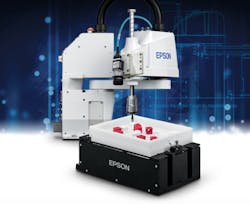Epson Robots debuted the two newest additions to its IntelliFlex flexible feeder system line-up at PACK EXPO Connects. The new additions are the IntelliFlex 80 for handling small parts (3mm to 15mm) and the IntelliFlex 380 for large parts (15mm to 60mm). These systems join the IntelliFlex 240 (for part sizes 5mm to 40mm) and the IntelliFlex 530 (for part sizes of 30mm to 150mm). These flexible feeder systems are used to feed consumer goods for packaging in kits, as well as sorting of electronics and medical device parts for packaging.
A key aspect of Epson Robots’ approach to flexible feeding systems is its all-in-one system delivery. Stacey Tieu, product manager at Epson Robots, explained that common flexible feeder systems are composed of separate feeder communication protocols; feeder tuning requirements; vision system calibration and programming; and system programming and optimization to coordinate the robot, feeder, and vision system. Epson Robots’ approach is to combine all these components into one system that integrates the vision programming, part tuning, and parts control adjustment. This allows for the Epson IntelliFlex system to be set up and running in one day, rather than the weeks it typically takes to set up a flexible feeder system, according to Tieu.
The IntelliFlex series can handle a variety of part sizes and types through its use of Epson’s RC+ integrated software environment, which is used to program and control all aspects of the flexible feeder system. “It’s also what enables the IntelliFlex to be set up so quickly,” Tieu added. “We have built-in command sets for parts feeding so that engineers don't have to figure this out themselves. The user interface provides a point-and-click way to program the feeder.”
The RC+ software environment’s use of artificial intelligence enables autotuning of the IntelliFlex system. Aaron Donlon, Epson Robots product manager, explained that, in the RC+ environment, “if you set up the system for one part and then need to move to the next part for a different product, setting up that new part in the system is very easy with all the built-in wizards. You literally just drop 10 parts on the feeder and it uses the built-in algorithm to determine the right set of vibrations or frequency to spread those parts out for optimized feeding. There’s no trial and error with this process, you just let the machine do the automated tuning calibration for you.”
Donlon noted that the longest he’s seen the system take to self-adjust to new parts is five minutes, but that the process typically takes about two minutes.
Leaders relevant to this article:


